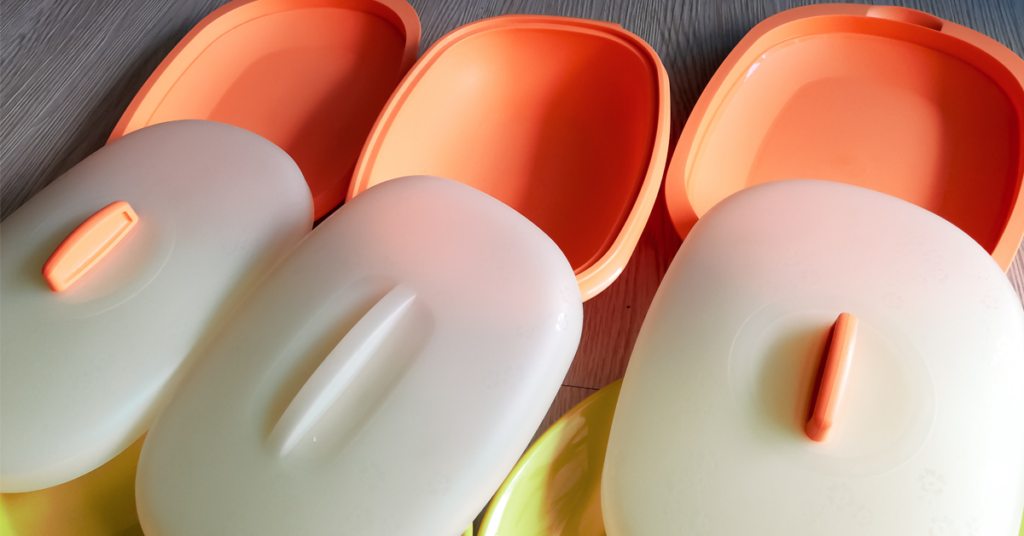Like most people, you probably have a few Tupperware containers in your kitchen. It is a household name for good reason – it’s durable, affordable, and most importantly, a great way to store food.
But can you use Tupperware in the microwave? You can use Tupperware in the microwave! Most containers don’t recommend using them, but some are microwave safe. Generally, you should avoid boiling liquids in a Tupperware container as this could cause leaking. Just make sure your carousel dish is covered for effortless rotating.
Using Tupperware in the microwave can also save you time and energy. One of the most common problems people face when using Tupperware in the microwave is knowing which containers are microwave safe.
Another common challenge is knowing how to use Tupperware in the microwave.
In this article, we will explore if Tupperware is safe to use in the microwave, and we will also provide tips on how to safely use Tupperware in the microwave. We will also discuss the benefits of using Tupperware in the microwave!

How to Check if Your Tupperware Containers Are Microwave Safe
Tupperware, to reduce the worry about microwaving, has included a thorough chart of plastics to assist customers in identifying the “Resin ID Codes” used in their plastic container goods.
Check to see whether the Tupperware container has a microwave-safe symbol marked by three wavy lines on the underside.
If you’re using Plastic Tupperware with no markings or a lack of microwave-safe logo or label on the bottom of the container, you should avoid doing so in your microwave appliance.
Numerous Tupperware goods aren’t designed for cooking, but the company offers a wide range of BPA-free and microwave-safe containers.
Also, if the plastic container is marked #5, it is made of PP (Polypropylene), so it’s safe to use in the microwave.
CPET#1 is also microwave safe. It’s only used to heat simple meal solutions for a matter of seconds. You should differentiate it from APET because CPET has been crystallized to aid in heat retention.
On the other hand, APET containers are not microwave-safe. It is the same plastic utilized in deli container production, water bottles, and another cold food packaging.
LEARN MORE: Can You Put Paper Towels in the Microwave?
Instructions on Using Tupperware in the Microwave
Using Tupperware in the microwave is one of the best ways to save time and energy. It is also a great way to heat your food without using a stove.
Check Your Tupperware Container Whether It Is Microwave-safe
Some Tupperware containers are designed for the microwave, and others are not. If you are not sure, check the bottom of your container or the packaging. If your container is not meant for use in the microwave, it could end up melting or becoming damaged.
It is important to note that even if a container is microwave-safe, not all materials used to make the container are. For example, lids on Tupperware containers may be made of a different material than the container itself. In this case, it is best to remove the lid before microwaving.
Check if Foods in Tupperware Have Reached a High-temperature
Fatty foods like meat and food cooked with boiling water reach very high temperatures while they heat. It can create toxins in your food, releasing them into the food you’re eating when microwaved in plastic containers.
The chemicals released from plastics when heated are known as “plasticizers” or “phthalates”. Phthalates are endocrine disruptors, meaning they interfere with our hormones.
They have been linked to various health problems, including cancer, infertility, congenital disabilities, and early puberty.
Though Tupperware microwave-safe containers have no threats of releasing, it’s best to avoid microwaving fatty foods in plastics, or any food in plastics for that matter. Also, don’t reheat them in long batches.
Use Tupperware Containers With a Vent
It is better to use Tupperware microwave containers with a vent if you have them. It’s essential to reheat your dinner in the microwave using the vent over the containers. The food will get chewy or beady because of direct exposure to microwaves, and the broth may evaporate.
Put Tupperware lid while microwaving meals to prevent splatter. It will also assist in the faster and more uniform heating of the food. But open the covers to allow for a slow release of pressure. If your container doesn’t have a vent, lifting the edges will do the same thing.
Follow the Manufacturer Instructions Properly
Tupperware advises that plastic container goods should be microwaved systematically. Systematic means you should avoid overcooking or reheating meals for extended periods, especially those with a lot of sugar or fat.
The high heat tolerance of fat and sugar is greater than the boiling point of water, 100°C or 212°F. So, the higher temperature of these ingredients can destroy the container.
It’s only advised to use Tupperware for reheating and defrosting meals. The plastic pots are not suggested for cooking.
The manufacturer also includes a caution not to exceed the suggested reheating times of 3 minutes. If your meal needs more heating time, consider pausing the microwave at a specific point and stirring the contents before continuing for another 3 minutes.
LEARN MORE: Can You Microwave Ziploc Bags?
Conclusion: Can You Put Tupperware in the Microwave?
Tupperware microwave products not only make reheating food more accessible but can also help keep your food warm or cold until you’re ready to eat it. Using different types of Tupperware in the microwave can be a great way to add variety to your meals.
Make sure to follow the tips above and always check the manufacturer’s instructions. With a bit of care, you can safely use Tupperware in the microwave. So, go ahead and give it a try!

